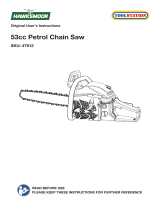
MS 201 T, MS 201 TC
English
5
Never refuel the machine while the
engine is still hot – the fuel may spill over
– risk of fire!
Open the fuel filler cap carefully so that
any excess pressure is relieved
gradually and fuel does not splash out.
The machine may only be refuelled in a
well ventilated place. Clean the machine
immediately if fuel is spilled. Do not spill
fuel over your clothing – contaminated
clothing must be changed immediately.
The machines can be equipped with the
following filler caps as standard:
Cliplock filler cap (bayonet-type)
This helps reduce the risk of unit
vibrations causing an incorrectly
tightened filler cap to loosen or come off
and spill quantities of fuel.
Before Starting Work
Check that your saw is properly
assembled and in good condition – refer
to appropriate chapters in the instruction
manual.
– Check the fuel system for leaks,
paying special attention to visible
parts such as the tank cap, hose
connections and the manual fuel
pump (on machines so equipped). If
there are any leaks or damage, do
not start the engine – risk of fire.
Have your saw repaired by a
servicing dealer before using it
again.
– Check operation of chain brake,
front hand guard
– Correctly mounted guide bar
– Correctly tensioned chain
– The trigger and trigger lockout must
move freely and spring back to the
idle position when they are
released.
– Master Control lever must move
easily to STOP, 0 or †
– Check that the spark plug boot is
secure – a loose boot may cause
arcing that could ignite combustible
fumes and cause a fire.
– Never attempt to modify the controls
or safety devices in any way.
– Keep the handles dry and clean –
free from oil and dirt – for safe
control of the saw.
– Make sure there is sufficient fuel
and chain oil in the tanks.
To reduce the risk of personal injury, do
not operate your saw if it is damaged or
not properly assembled.
Starting the Saw
Start the saw on level ground only. Make
sure you have a firm footing. Hold the
saw firmly. To reduce the risk of injury
from the rotating chain, check that the
cutting attachment is not touching any
object or the ground .
The chainsaw is a one-person saw. Do
not allow other persons in the work area
– even when starting.
Do not attempt to start the saw when the
saw chain is in a cut.
Starting the saw in a tree is very
dangerous since the user may lose
control of the machine – risk of injury.
The tree surgery saw should be
checked, fueled, started and warmed up
by an assistant on the ground before it is
transported up to the operator in the
tree.
Start the engine at least 3 meters from
the fueling spot, outdoors only.
To reduce risk of chain rotation and
personal injury, lock the chain with the
chain brake before starting.
Do not drop start the power tool – start
the engine as described in the
instruction manual.
Place the cliplock filler
cap (bayonet-type) in
position, turn as far as
stop and fold the cliplock
down.
Look out for leaks! Never
start the engine if fuel has
been spilled or is leaking
– Fatal burns may result!





















